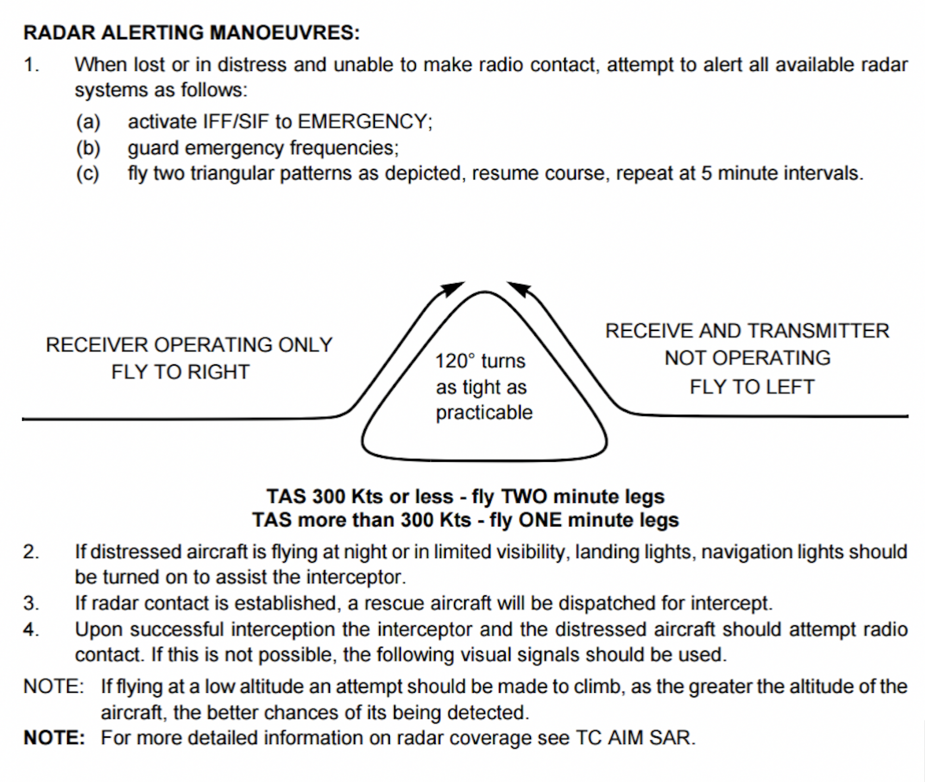Honestly, I’ve never heard of this. I’m pretty sure it wasn’t even in my (otherwise comprehensive) PPL theory book.
Chaff, an environmental offense these days!
I was flying a Bellanca Viking westward toward Quebec City many years ago. Vikings, being primarily wood and fabric have a poor radar return, so I was of course, using my transponder. at 70 miles east, inbound, I was positively identified. After a couple of minutes, the controller asked me to have a look off to my right for a flock of birds. Sure enough, I was passing a large flock of Canada Geese – and he was picking them up on radar – 65 miles out!
We now fly in an age when there are many appropriate actions, and solutions for being lost. When I started flying, transponders were only for large airplanes, and GPS and cell phones were not yet even a twinkle in a technologists eye. And, in Canada, the very few areas with radar coverage were populated enough that getting lost there was less likely. When we got north back in the day, with trees, rock, and lakes, no radar, no GPS (even now, cell phones don’t work up there), good map reading and flight logs were pretty important! An ADF signal was a luxury at low altitude!
Standard Comms failure procedure as long as I can remember.
Yes, I remember being taught this in the PPL theory course about 9 years ago. As said above, there are many other options available today (and technology that makes it harder to get lost in the first place).
This is still in the Canada Flight Supplement, and was taught as part of Canadian PPL training.

How do you know your transmitter is operating but your receiver is not? (For right or left triangle.)
I have not gone through training in Europe ever. But in flight schools and BFR/s in the U.S. this was never used or mentioned.
If lost (in VMC hopefully) apply ANC, if you can’t communicate (C) use 7600, if your transponder fails too then stay clear of (or leave) class B, C, D airspace and land as soon as practicable.
Would one really fly the triangles and then patiently wait for the interceptor (no feedback possible) while burning the remaining fuel ?
Indeed; I do wonder what scenario this would be applicable to.
In GA we rarely have loads of fuel to play with, who is going to intercept you in Europe and how long will they take, and flying triangles (if you really are lost) will likely just reinforce a CAS bust, shutting down a major airport for hours while your triangle keeps popping into their airspace 
In big jets you usually are on minimum fuel the whole time; definitely cannot use this.
In the military, fast jets have even smaller reserves.
This is obviously old. It assumes radar, so presumably WW2.
I think the basic problem with it is that most aircraft end their planned journey with not a lot of fuel, so the applicability is really to getting lost well before the destination.
I once considered flying a triangle over Guildford. Perhaps I even did a few legs – I can’t remember but evening was approaching and I was trying to work out how to get to Blackbushe legally without a working radio. It’s an experience I often think back to whilst reading the infringement thread.
I always remember left hand triangles (total radio failure) as being more sinister than right hand triangles (transmit failure only).
The speechless code I remember partially due to ‘Woof’, a children’s programme in the 80s about a boy who periodically turns into a dog. One bark for ‘yes’. Two barks for ‘no’.
I eventually solved the problem by plugging my headset into the passenger sockets and using the passenger PTT switch. I had tried both steps separately early on, but hadn’t realised that the PTT switches were separate and only worked for the pilot or passenger headset respectively. When I returned the plane, late but quite pleased with myself, I was told that I shouldn’t have been flying if I hadn’t fully understood how the radios worked.
That’s the trouble with esoteric knowledge. There’s so much of it, and it might all be useful sooner or later.
Flying a triangle is certainly less likely needed these days, then 30 years ago, when it was done from time to time. Historically, were I to think to do this, it would be to “announce” my intention to do something nordo. I would fly a few triangles, as my fuel and situation allowed, then go and land where I needed to (like a controlled airport without a clearance). The controller would at least know something unusual was about to happen, and get everyone out of the way. The key is that once you leave the triangle, fly a directly as you can to the next point (airport) you plan, don’t meander around. Give the controller a chance to anticipate what you’re going to do, then do that.